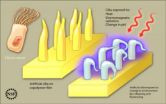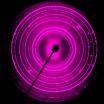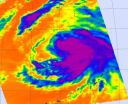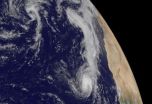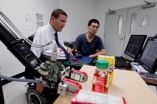(Press-News.org) University of Southern Mississippi scientists recently imitated Mother Nature by developing, for the first time, a new, skinny-molecule-based material that resembles cilia, the tiny, hair-like structures through which organisms derive smell, vision, hearing and fluid flow.
While the new material isn't exactly like cilia, it responds to thermal, chemical, and electromagnetic stimulation, allowing researchers to control it and opening unlimited possibilities for future use.
This finding is published in today's edition of the journal Advanced Functional Materials. The National Science Foundation's Division of Materials Research supports Southern Miss's Materials Research Science and Engineering Center for Response-Driven Polymeric Materials, where the research took place.
Cilia are wavy, hair-like structures that extend outward from the surfaces of various organisms such as human skin. People, animals and single-celled organisms use them to sense the environment, gather information about it and adapt to it.
Scientists long imagined what could be done if they could engineer cilia for other organic and nonorganic uses. But creating them solely belonged to the life nurturing processes of nature, until now. Marek Urban, Southern Miss professor of polymer science and engineering, along with a team of researchers, developed a new thin copolymer film with whisker-like formations that mimics Mother Nature.
"Our interest is in developing materials with multi-level responses at various length and time scales," said Urban. "I believe this is the future of science and engineering that will drive future technologies."
Employing a process used for years to produce latex paints, the researchers formed thin copolymer-based films whose chemical composition makes possible filaments that have built-in molecular sensors that respond to temperature, acidity and ultraviolet radiation. Moreover, the filaments are capable of locomotion, waving, shrinking and expanding in response to stimuli. They also are capable of fluorescence, that is, absorbing and emitting light and changing colors as a reaction to ultraviolet rays.
The ability to engineer this cilia-like biosensor may give scientists an ability to, for example, test for the presence of toxins, oxygen or even lack of oxygen in an environment. Future opportunities for sensor use might include developing new sensors for testing glucose levels, using the sensors for drug testing, or testing for air or water safety.
There is no limit to dreaming up applications for such a material, said Urban. "Many new ideas are being generated as we speak, but it is too early to reveal them."
Immediate next steps will be to team up engineers to make use of the materials.
INFORMATION:
Former Southern Miss graduate students Fang Liu, who now works with Proctor and Gamble, and research associate Dhanya Ramachandran contributed to this research.
Cilia revolution
Man-made, hair-like structures poised to change industry paradigms
2010-09-24
ELSE PRESS RELEASES FROM THIS DATE:
Taking a new look at old digs: Trampling animals may alter Stone Age sites
2010-09-24
Archaeologists who interpret Stone Age culture from discoveries of ancient tools and artifacts may need to reanalyze some of their conclusions.
That's the finding suggested by a new study that for the first time looked at the impact of water buffalo and goats trampling artifacts into mud.
In seeking to understand how much artifacts can be disturbed, the new study documented how animal trampling in a water-saturated area can result in an alarming amount of disturbance, says archaeologist Metin I. Eren, a graduate student at Southern Methodist University, Dallas, and ...
High pressure experiments reproduce mineral structures 1,800 miles deep
2010-09-24
University of California, Berkeley, and Yale University scientists have recreated the tremendous pressures and high temperatures deep in the Earth to resolve a long-standing puzzle: why some seismic waves travel faster than others through the boundary between the solid mantle and fluid outer core.
Below the earth's crust stretches an approximately 1,800-mile-thick mantle composed mostly of a mineral called magnesium silicate perovskite (MgSiO3). Below this depth, the pressures are so high that perovskite is compressed into a phase known as post-perovskite, which comprises ...
Cancer-associated long non-coding RNA regulates pre-mRNA splicing
2010-09-24
CHAMPAIGN, Ill. — Researchers report this month that MALAT1, a long non-coding RNA that is implicated in certain cancers, regulates pre-mRNA splicing – a critical step in the earliest stage of protein production. Their study appears in the journal Molecular Cell.
Nearly 5 percent of the human genome codes for proteins, and scientists are only beginning to understand the role of the rest of the "non-coding" genome. Among the least studied non-coding genes – which are transcribed from DNA to RNA but generally are not translated into proteins – are the long non-coding RNAs ...
GOES-13 sees tropical depression 15 form in the south-central Caribbean Sea
2010-09-24
The fifteenth tropical depression of the Atlantic Ocean season has formed in the south-central Caribbean Sea, and the GOES-13 satellite captured its swirling mass of clouds and showers in a visible image today. Watches and warnings are already up for Central America.
At 2 p.m. EDT today, Sept. 23, Tropical Depression 15 had maximum sustained winds near 35 mph. It was located about 485 miles east of Puerto Cabezas, Nicaragua, near 13.9 North and 76.2 West. It was moving west at 15 mph, and had a minimum central pressure of 1007 millibars.
The government of Nicaragua ...
NASA sees important cloud-top temperatures as Tropical Storm Malakas heads for Iwo To
2010-09-24
NASA's Aqua satellite has peered into the cloud tops of Tropical Storm Malakas and derived just how cold they really are, giving an indication to forecasters of the strength of the storm.
The Atmospheric Infrared Sounder instrument, known as AIRS has the ability to determine cloud top and sea surface temperatures from its position in space aboard NASA's Aqua satellite. Cloud top temperatures help forecasters know if a storm is powering up or powering down.
When cloud top temperatures get colder it means that they're getting higher into the atmosphere which means the ...
NASA satellites help see ups and downs ahead for Depression Lisa
2010-09-24
Tropical Depression Lisa has had a struggle, and it appears that she's in for more of the same.
Infrared satellite imagery from the Atmospheric Infrared Sounder (AIRS) instrument on NASA's Aqua satellite shows that the convection (rapidly rising air that forms thunderstorms that make up a tropical cyclone) is increasing in Lisa. The convection is becoming a little better organized and stronger which is will make for some heavy rainfall over the northwestern Cape Verde Islands. It's also an indication that she may be strengthening back into a tropical storm today.
That ...
Team of researchers finds possible new genetic risk for Alzheimer's disease
2010-09-24
Researchers have identified a gene that appears to increase a person's risk of developing late-onset Alzheimer's disease, the most common form of the disease. The gene, abbreviated as MTHFD1L, is on chromosome six, and was identified in a genome-wide association study. Details are published September 23 in the journal PLoS Genetics.
The collaborative team of researchers was led by Margaret A. Pericak-Vance, PhD, Director of the John P. Hussman Institute for Human Genomics at the University of Miami Miller School of Medicine; Joseph D. Buxbaum, PhD, Department of Psychiatry, ...
Earth: Fixing Pakistan's water woes
2010-09-24
Pakistan is facing tremendous water issues. This summer's flooding has left millions of people without homes and without access to clean drinking water. But water issues - both quantity and quality - are not new to this strategically important country. Waterborne diseases account for 30 percent of all deaths in Pakistan, and kill some 250,000 children each year. Per capita water availability in Pakistan is less than one-ninth of what it is in the U.S. And what's more, researchers say if Pakistan doesn't manage its water resources differently, it's going to actually run ...
Robotic arm's big flaw: Patients say it's 'too easy'
2010-09-24
One touch directs a robotic arm to grab objects in a new computer program designed to give people in wheelchairs more independence.
University of Central Florida researchers thought the ease of the using the program's automatic mode would be a huge hit. But they were wrong – many participants in a pilot study didn't like it because it was "too easy."
Most participants preferred the manual mode, which requires them to think several steps ahead and either physically type in instructions or verbally direct the arm with a series of precise commands. They favored the manual ...
Black motorcyclists -- even in helmets -- more likely to die in crashes
2010-09-24
African-American victims of motorcycle crashes were 1.5 times more likely to die from their injuries than similarly injured whites, even though many more of the African-American victims were wearing helmets at the time of injury, according to a new study by Johns Hopkins researchers.
Results of the research revealing these racial disparities, published in the August issue of the American Journal of Surgery, suggest that injury-prevention programs — like state laws mandating the use of motorcycle helmets — may not be sufficient to protect all riders equally.
"For reasons ...
LAST 30 PRESS RELEASES:
Statins significantly reduce mortality risk for adults with diabetes, regardless of cardiovascular risk
Brain immune cells may drive more damage in females than males with Alzheimer’s
Evidence-based recommendations empower clinicians to manage epilepsy in pregnancy
Fungus turns bark beetles’ defenses against them
There are new antivirals being tested for herpesviruses. Scientists now know how they work
CDI scientist, colleagues author review of global burden of fungus Candida auris
How does stroke influence speech comprehension?
B cells transiently unlock their plasticity, risking lymphoma development
Advanced AI dodel predicts spoken language outcomes in deaf children after cochlear implants
Multimodal imaging-based cerebral blood flow prediction model development in simulated microgravity
Accelerated streaming subgraph matching framework is faster, more robust, and scalable
Gestational diabetes rose every year in the US since 2016
OHSU researchers find breast cancer drug boosts leukemia treatment
Fear and medical misinformation regarding risk of progression or recurrence among patients with breast cancer
Glucagonlike peptide-1 receptor agonists and asthma risk in adolescents with obesity
Reviving dormant immunity: Millimeter waves reprogram the immunosuppressive microenvironment to potentiate immunotherapy without obvious side effects
Safety decision-making for autonomous vehicles integrating passenger physiological states by fNIRS
Fires could emit more air pollution than previously estimated
A new way to map how cells choose their fate
Numbers in our sights affect how we perceive space
SIMJ announces global collaborative book project in commemoration of its 75th anniversary
Air pollution exposure and birth weight
Obstructive sleep apnea risk and mental health conditions among older adults
How talking slows eye movements behind the wheel
The Ceramic Society of Japan’s Oxoate Ceramics Research Association launches new international book project
Heart-brain connection: international study reveals the role of the vagus nerve in keeping the heart young
Researchers identify Rb1 as a predictive biomarker for a new therapeutic strategy in some breast cancers
Survey reveals ethical gaps slowing AI adoption in pediatric surgery
Stimulant ADHD medications work differently than thought
AI overestimates how smart people are, according to HSE economists
[Press-News.org] Cilia revolutionMan-made, hair-like structures poised to change industry paradigms
